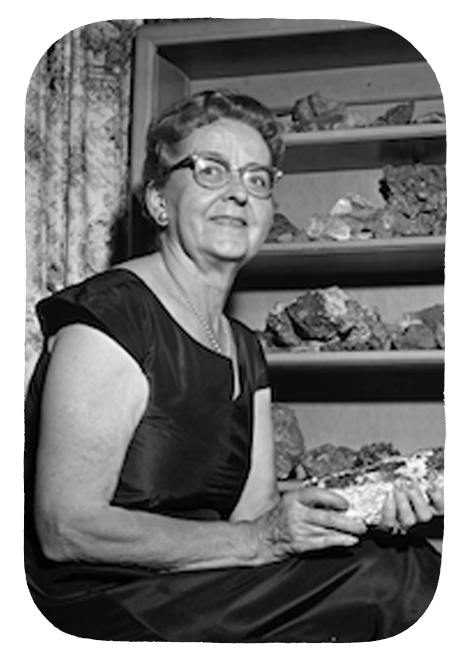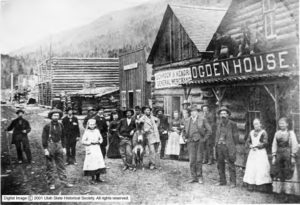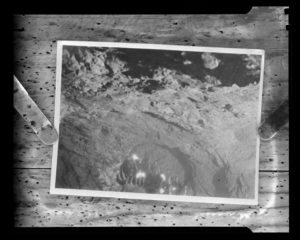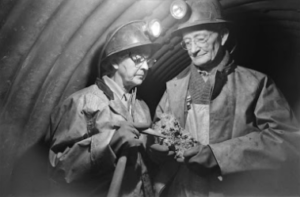
Additional Resources
Desdemona Stott Beeson,
Foremost Utah Woman in Mining
1897-1976
by Naomi Watkins
Former Education Director, Better Days
Born in Eureka, Utah, then a booming silver mining town, to Bradford N. C. Stott and Emma Newton Darst, Desdemona Stott grew up immersed in mining life and had a fascination with mines from a young age. The world of mining, and especially its underground depths, were forbidden to women, but as a young girl, Desdemona rode the cage down the mine shaft with the manager of the mine near her home. Her brother also worked in the mines, and he would bring her into them to explore. Desdemona recalled being especially struck by the beauty of the natural world when she saw a newly-discovered, giant cavity of silver. The mines were off-limits to her once she became a teenager, but she convinced a man she dated to let her spend evenings with him in the nearby Mammoth Mine. She tried to be in the mines as often as she could.

Alta, Utah–site of the Emma Mine. Photo courtesy of Utah State Historical Society.
When Desdemona enrolled at the University of Utah, she wanted to study engineering and geology, but her parents objected to her interest in this male-dominated field, so she studied and graduated in psychology instead. During her junior year, her newlywed brother who lived at the Alta mining camp in Little Cottonwood Canyon needed a cook since his wife could not manage cooking in the tent in which they lived. So he asked Desdemona to spend the summer months with them. Alta was in the midst of a mining boom. Her brother was a mining engineer, and his position allowed Desdemona some access to the mines. While underground, she met Joseph J. Beeson, a Stanford-educated geologist. He had been hired to find an ore body in the Emma Mine, a search that previous mine owners had abandoned. They were married a year later and lived in a 12×14 foot tent at Alta. Their living conditions slightly improved when Joe’s search for the lost ore body proved fruitful and he and the mine made world headlines.
When the United States entered World War I in 1917, Joe enlisted and was sent to Europe as an army engineer. After suffering a miscarriage, Desdemona decided to enroll in Stanford University to formally learn about mining engineering and geology. At Stanford, Desdemona was met with discrimination as a woman in the mining and engineering worlds, particularly by some of her professors, and even though she had more first-hand experience in mines than many of her male counterparts. However, she enjoyed her classes and expanding her knowledge and expertise.

The Emma Mine in Alta, Utah. Photo courtesy of Utah State Historical Society.
Once Joe returned from the war one-and-a-half years later, Desdemona joined him at his work at the Bingham Mine, and they began their joint lifetime venture as mining entrepreneurs. Over several decades, the couple owned and worked at several mines. As with most mining pursuits, some of these ventures were successful; others were not. They moved where the work beckoned. Joe studied the geology and Desdemona researched old courthouse records, kept the books, and managed the mines when Joe was away on consulting jobs. “Her practical knowledge of the mining industry coupled with her husband’s skill in mining operations was usually a successful combination.”[1]
For the most part, her presence at the mines was tolerated well by the miners–yet one miner once objected to having his paycheck signed by a woman. On another occasion, the miners went on strike. “They wanted to be paid from the time they left the boarding house in the morning until they returned from work at a tunnel high on the mountain. Since this differed from Utah practice, Desdemona hurriedly drove one hundred miles to Elko to check Nevada law, then returned and nailed the relevant statute to the boarding house door. She informed the men that if they did not want to work under her conditions she would pay them off. Her determination and poise won the day and the strike ended.”[2]
Desdemona was an especially hard worker. While pregnant, Desdemona helped stake the claims, carrying 4×4 posts. She was hospitalized several times for the long hours she worked and because of the hazardous working conditions. And while the miners may have respected Desdemona’s authority, often her professional colleagues did not. She was occasionally refused admittance underground even though she was a professional. “When a diamond drill crew made some careless errors in procedure she gave them a scathing lecture on the unacceptability of such sloppy workmanship. She once fired a husky workman for using a shovel to catch the drill sludge. When he balked at leaving, she yelled at him, ‘You get out of here or I’ll wrap that shovel around your neck!’ He quickly left.”[3]
As was the case for many women, work opportunities opened for Desdemona with the onset of World War II. She consulted for coal companies, secured several government contracts and positions, and spent most of the war working for the Foreign Economic Administration, monitoring world metal production and demand and purchasing metals from abroad, including uranium. However, when the war ended, she, like most women at the time, found that she could no longer continue in her current position. Instead, she was offered a job as a secretary with the company for the same pay. Desdemona quit and eventually set up Beeson Enterprises with Joe.

Desdemona and Joseph Beeson, 1961. Photo courtesy of Utah State Historical Society.
They began a mining venture in St. George that proved successful, but then “the dangers always inherent in the mining business caught up with them. While she was checking out a section of the mine a huge mass of rock gave way, striking Desdemona and breaking her neck. She had to spend months in the hospital, since she was badly injured. As she said later, ‘It didn’t cure me. I was back working in a neck brace.’”[4] After a fall that broke her ankle, Desdemona again continued working in spite of doctors telling her to quit going underground. She showed up to work not only wearing her neck brace, but an ankle brace, too.
In the 1950s, the Beesons returned to Alta and the pair worked at the Cardiff Mine, completing what Desdemona considered their most challenging project. “She helped connect the Wasatch Drain Tunnel with the water-filled workings of the Cardiff Mine, then helped figure out how to mine below the tunnel level. The Beesons sank a shaft down from the end of a 2-mile-long tunnel and installed power lines and pumps to pump out the water that continually flowed into the mine.”[5]

Desdemona Stott Beeson, 1963. Photo courtesy of Utah State Historical Society.
The couple remained at Alta into the late 1960s until developers bought them out to build the Snowbird Ski Resort. The two retired due not only to the sale, but also to several persisting medical conditions. They were elected honorary life members of the Utah Geological Association. Desdemona concluded their acceptance speech: “Together we have added new money to the state, had a good payroll, and thoroughly enjoyed being hard rock miners.”[6] They were also appointed lifetime honorary citizens of Alta in 1974.
Their relationship appears to have been a true partnership. “Joe provided the more theoretical and scientific bases for finding ore while Desdemona was, as she put it, ‘the practical nuts and bolts’ of the operation, working as manager, bookkeeper, and mining engineer together with her husband in the rugged world of underground mines.” Desdemona died of cancer at age 78 and was a trailblazer in the mining, engineering, and business worlds.
Footnotes
[1] James, Laurence P., and Sandra C. Taylor. “‘Strong-Minded Women’”: Desdemona Stott Beeson and Other Hard Rock Mining Entrepreneurs,” Utah Historical Quarterly, 46, 2, Spring 1978, pp. 136-150.
[2] “‘Strong-Minded Women’”
[3] “‘Strong-Minded Women’”
[4] “‘Strong-Minded Women’”
[5] Rogers-Iversen, Kristen. “Living History: Utah Woman was a Mining Pioneer,” The Salt Lake Tribune, 25 November 2010. https://archive.sltrib.com/article.php?id=50745293&itype=CMSID
[6] “Strong-Minded Women”

